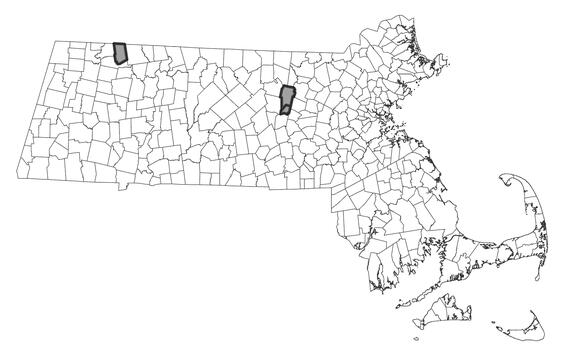- Scientific name: Potamogeton gemmiparus
- Species of Greatest Conservation Need (MA State Wildlife Action Plan)
Description
Budding pondweed is a submersed aquatic species with delicate leaves, floating under the surface of lakes or slow-moving rivers in New England.
Pondweeds in general can be one to several feet in length and vary quite a bit depending on growing conditions, whether near the shore of a shallow lake or in a slow-moving stream. They often have two forms of leaves, one under the surface and another type that floats on the surface. Budding pondweed has only the submersed type of leaves. The leaves on budding pondweed are widely spaced along the stem and are extremely narrow, essentially threadlike, less than a millimeter in width (0.04 in). They can be up to 6 cm (2.5 in) long. There is a significant stipule where the leaf attaches to the stem. The stipule acts like an extra leaf but is shorter. It wraps around both the base of the leaf and the stem itself. Right at the juncture of the base of the stipule is a small gland. The apex of the leaf is acute (sharply pointed). The few flowers are held on peduncles (flower stems) that are up to 3.5 cm (1.4 in) in length. Eventually, small single-seeded fruits are formed that are also quite small, more or less round with a little beak on one end, and only about 2.2 mm (0.09 in) in diameter.
The species is also known as Potamogeton pusillus L. subsp. gemmiparus (J.W. Robbins) Haynes & C.B. Hellquist.
Budding pondweed looks almost identical to tiny pondweed (Potamogeton pusillus) and was once considered part of this species. It is also similar to Berchtold's pondweed (Potamogeton berchtoldii). The leaves on these two species are generally a little wider than budding pondweed, up to 2.5 mm (0.1 in) in width. In addition, they have 3-5 veins in the leaf, whereas budding pondweed has only one vein. The peduncles that hold the flowers tend to be shorter in budding pondweed, up to 3.5 cm (1.4 in) in length, whereas those of the other two species are up to 8 cm (3 in) in length.
Population status
Budding pondweed is known from seven central counties. Many of the records are older than 1980.

Distribution in Massachusetts. 1999-2024. Based on records in the Natural Heritage Database
Distribution and abundance
The range of budding pondweed is highly restricted. It is considered a near-endemic species in New England. In other words, it is found in New England and nowhere else in the world except in nearby areas of Quebec.
Habitat
Budding pondweed is found most often in acidic or circumneutral waters of lakes and slow-moving streams or rivers.
Healthy habitats are vital for supporting native wildlife and plants. Explore habitats and learn about conservation and restoration in Massachusetts.
Threats
There are frequent demands for controlling aquatic vegetation that involve the use of herbicides, which will most likely eliminate this species from a body of water. The invasive Eurasian watermilfoil is in part to blame for the growth of nuisance levels of aquatic vegetation. Control of the spread of this non-native invasive species is important.
Management Recommendations
Actions that prevent invasive species from entering water bodies—such as cleaning all boats and motors at boat landings before moving to another lake—are very important. Also important is following best management practices for any activities that disturb the soil in the watershed of a waterbody where this aquatic plant occurs.
References
Crow, G.E., and C.B. Hellquist. 2006. Aquatic and Wetland Plants of Northeastern North America, Volume II: A Revised and Enlarged Edition of Norman C. Fassett's A Manual of Aquatic Plants, Volume II: Angiosperms: Monocotyledons (Vol. 2). University of Wisconsin Press.
Haines, A. 2011. New England Wild Flower Society's Flora Novae Angliae: A Manual for the Identification of Native and Naturalized Higher Vascular Plants of New England. Yale University Press.
Contact
| Date published: | May 5, 2025 |
|---|